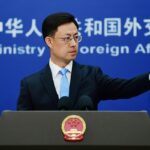
A few years ago, the Marines decided that they would need to fight communist China, an effort requiring major changes that would take years to make. They are currently in the middle of this project, called Force Design 2030.
The Marine Corps has mothballed many tanks, helicopters, and landing ships. They have phased out much infantry and artillery. They are reshaping the Corps into an anti-ship missile force to be based on lands surrounding the China Sea.
In a nutshell, “At the policy level, Force Design 2030 focuses the Marine Corps narrowly on a maritime conflict in the Pacific with the PRC at the expense of the ability to perform other missions in other theaters.”
A gamble
The Marine Corps is trading broad general capabilities for a single capability that may never be needed.
If there is a war with Red China and the Marine rocket installations are not detected, they may be able sink some naval vessels. But this would be an entirely new job for the Marines, who, thanks to the Force Design mandates, would be unable to perform any other function.
This gamble stakes all on such a war. Until that war comes, the once flexible, deployable, and powerful USMC is now a static, withered, technocratic force that is unable to perform any of its statutory missions.
Yes, statutory missions. How did the service get around these requirements without any change in the law or repeal of the law?
From 10 U.S. Code § 8063: “The Marine Corps shall be organized, trained, and equipped to provide fleet marine forces of combined arms, together with supporting air components, for service with the fleet in the seizure or defense of advanced naval bases and for the conduct of such land operations as may be essential to the prosecution of a naval campaign.”
If the Marines become an anti-ship missile unit, and this is considered “such land operations as may be essential,” they are still not off the hook for “fleet marine forces of combined arms, together with supporting air components, for service with the fleet in the seizure or defense of advanced naval bases.”
But they have let themselves off the hook.
Five ignored concerns
The mission as stated in law had its defenders before the Corps got out of hand. Starting in 2020, hundreds of former Marines came together to lobby against Force Design 2030.
In 2022, Generals James Amos and John Sheehan spoke for this group when they wrote:
What, exactly, are our concerns? They fall into five categories: (1) the myopic focus on one enemy in one geographical region employing one method with a defensive orientation; (2) the devastating reduction of operational capabilities for global response; (3) the loss of currently needed capabilities for two to seven or more years and the associated risk these reductions pose to national security, all incurred with the “divest to invest” approach to modernization; (4) the unusual way in which force structure decisions were made outside of the highly regarded combat development process; and (5) the adoption of personnel plans that are likely to destroy the culture and ethos of the Corps, attributes that have enabled Marines to fight and win some of the nation’s most difficult battles.
The military establishment ignored their concerns.
Maybe the Army can become the amphibious landing specialist, as in WWII. The Army already has infantry, its own navy and even air force. And the Army owes the Marines this favor for all the times the Marines acted as Army infantry in the deserts of Iraq and Afghanistan.
But can these be healthy organizations where everyone is doing everyone else’s job?
And what if there were a war with Red China?
The Marines propose to deploy missiles to territory that they do not (yet?) have permission to occupy. The missile sites will be fixed, not mobile, viewable by satellites and other reconnaissance platforms, targetable by hypersonic missiles, drones, aircraft, conventional missiles, naval gunfire, commandos, what have you.
And once those Marine launch sites are wiped out and their attendant Marines rocket troops are killed or wounded, who will stop the PLA’s very own naval infantry from storming and seizing the positions? With casualties mounting, how long will it take to train and deploy more missile specialists? Who will retake the lost positions?
Truly, “We cannot fix Force Design,” argues Gary Anderson. “The Pentagon and DOGE, or some combination thereof, should put Force Design out of it misery.”
Self-crippling dynamic
Whether shore-based or sea-based, anti-ship missile work is Navy work. If it has to be Marine work, which is improbable, logic would dictate that Congress add to the Marines’ capabilities rather than subtract from them. In the Marines today, we have a self-crippling dynamic addressing one specialized use whose day may never come.
We are scrapping the Marines (as we know them) to give the Marines some marginal and dubious anti-ship capabilities. How can that be worth the trade?
In the limits placed on the Marine Corps, perhaps Red China has already scored a victory.
Also see:
National Interest: “Former Marine Generals: ‘Our Concerns With Force Design 2030’ ”
National Interest: Force Design 2030 Is Trying to Solve the Wrong Problem
“An impulse is not the same as an actionable operational concept….”












